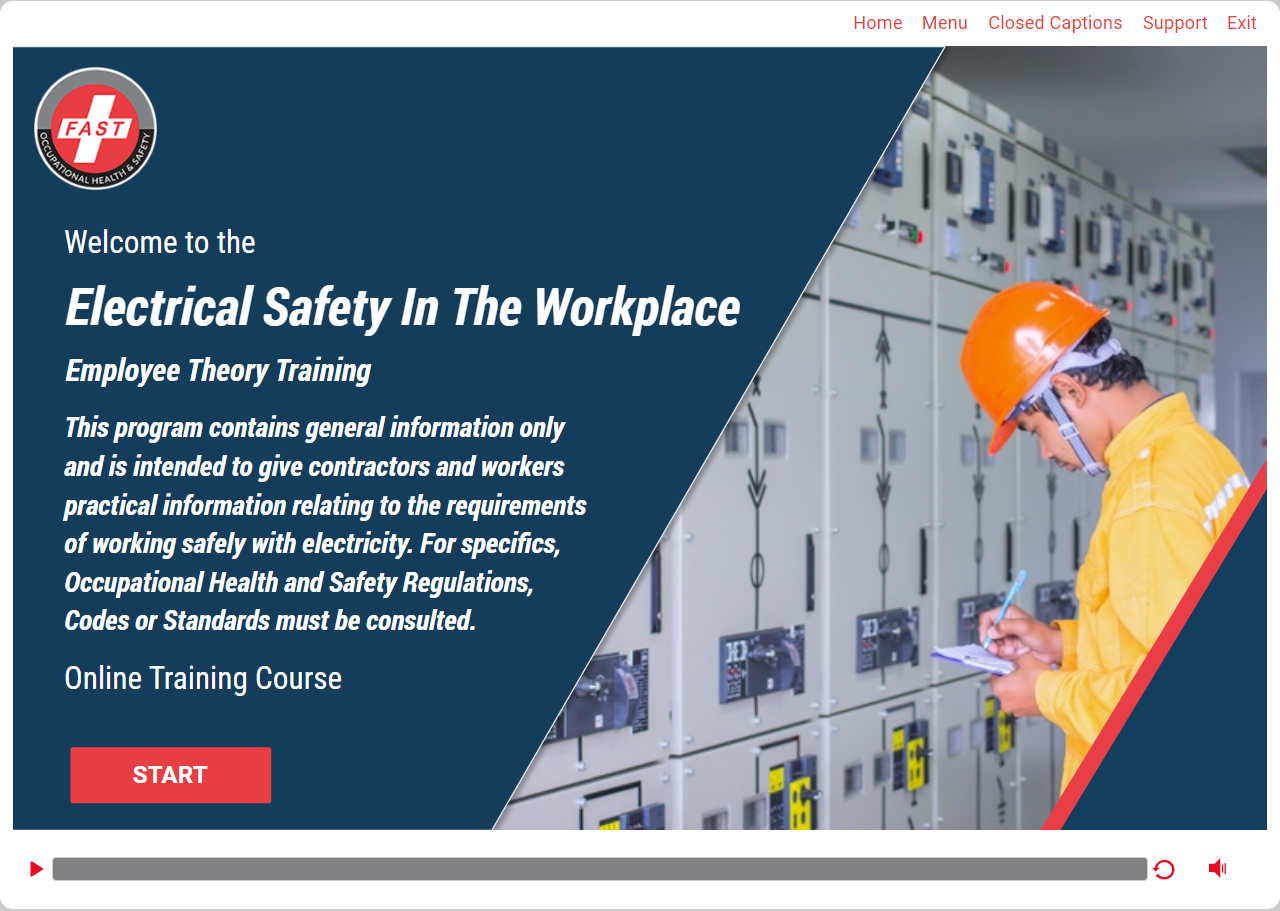
Electrical Safety CSA Z462 Online Training Course
(E-SESG-E)
Introduction to Electrical Safety CSA Z462 Online Training Course
Occupational Health and Safety (OHS) – Electrical Safety Online Training Program
The module “Electrical Safety in the Workplace” provides the required knowledge and awareness training for employees’ on working safely to avoid electrical hazards. This program is intended to provide workers relating to the requirements of working safety with electricity.
Electrical safety allows employees to work safely at the workplace, thereby preventing electrical hazards such as electric shocks, electric burns, etc.
ELECTRICAL SAFETY ONLINE TRAINING COURSE OUTLINE
The course covers the following topics:
1. ELECTRICAL SAFETY
Electrical safety encompasses the practices, guidelines, and precautions implemented to prevent accidents, injuries, or damage arising from the use of electricity. In this chapter, you will learn why electricians and others require additional electric safety training.
2. WHAT IS A QUALIFIED EMPLOYEE?
This chapter describes what a qualified employee should possess in order to perform electricity tasks safely. Also, it covers examples of safety training that are not limited to but used in the electrical safety training.
3. WHAT IS AN UNQUALIFIED EMPLOYEE?
Know who is an unqualified employee in terms of electrical safety.
4. ELECTRICAL HAZARDS
Electrical hazards refer to potential dangers and risks associated with the use, generation, transmission, or handling of electricity that can lead to accidents, injuries, or damage. In this chapter, you will learn about the things included in electrical hazards along with the relevant images.
The following things are included in the electrical hazards:
1. Electric Shock
2. Electrical burns
3. Arc Flash
4. Arc Blast – worst
5. Electrical Explosions
6. Low Current Electric Shock
7. High Current Electric Shock
8. Electric Arcs and Blasts
9. Hand Injuries and Burns from Troubleshooting
10. Isolating Circuits
Each sub topic is presented concisely using appropriate images.
5. UNDERSTANDING RISK AND REWARD
This chapter covers examples of risk and reward to perform the tasks efficiently. In this chapter, the workers are instructed to approach the manager if they are not sure how to perform a task.
6. ELECTRICAL LOCKOUT
Electrical lockout is a safety procedure that involves isolating and securing electrical power sources by using lockout devices and tagout devices. In this chapter, you will learn about the electrical lockout and circuit devices that must be de-energized, locked out, tagged out, and tested. It is important to note that control control circuit devices such as push button, selector switches, and interlocks may not be used for de-energizing equipment.
7. RELEASE STORED ENERGY
Stored electric energy must be released before starting work. Ensure all capacitors have been discharged and short-circuit and ground all high capacitance elements.
This chapter describes the stored electric energy that must be released before starting the work. Also, learn about the following chapters of stored energy.
1. Is it dead?
2. Check your tester
8. REMEMBER
In this chapter, checking and verification points have been given regarding test equipment. All the points are mentioned in the precise manner along with an image.
9. RE-ENERGIZING EQUIPMENT
Re-energizing equipment refers to the process of restoring electrical power to machinery or systems after a period of de-energization, maintenance, repair, or servicing. This chapter provides brief information in the form of bullet points regarding re-energizing equipment to help works understand about the things that need to be taken care of for re-energizing equipment.
10. ELECTRICAL HOT WORK
Electrical hot work refers to activities involving welding, cutting, soldering, or any other processes that generate heat, sparks, or flames in proximity to electrical systems or equipment. In this chapter, you will learn about the electrical hot work that introduces additional or increased hazards in terms of safety, not productivity.
An easy-to-comprehend point has been given to familiarize individuals with the proper use of special precautionary techniques (Approach Boundaries),
personal protective equipment, insulating, and shielding materials, and insulated tools.
11. APPROACH BOUNDARY
Learn about the safe approach distance from exposed electrical conductors or circuit parts as an effective means of maintaining electrical safety. An engaging and comprehensive data has been given along with relevant images to explain learners about the approach boundary.
12. FLASH PROTECTION BOUNDARY
The flash protection boundary is a designated area surrounding energized electrical equipment or systems where a worker faces potential exposure to thermal radiation during a fault or arc flash incident. Learn about the flash protection boundary along with the diagrammatic representation. This chapter describes the person’s eligibility to perform tasks within the Flash Protection Boundary (FPB).
13. ELECTRICAL PERSONAL PROTECTION EQUIPMENT
Electrical Personal Protection Equipment (PPE) refers to specialized gear and garments designed to safeguard individuals from electrical hazards during work activities. In this chapter, you will learn all the electrical personal protective equipment (PPE) that are needed to perform the electricity works safely. Electrical PPE includes:
1. Flame-resistant (FR) rated clothing
2. Eye/face protection
3. Head protection
4. Hand/arm protection
14. HAZARD/RISK CATEGORY CLASSIFICATIONS
This chapter describes what PPE should be worn based on the hazard and the electrical tasks performed. Learn in detail about the hazard/risk category classification that are given in the chart.
15. FR CLOTHING SELECTED
In this chapter, you will learn about the Flame-Resistant (FR) Clothing System in an easy-to-learn and retain manner. Also, learn about the following that are described precisely along with relevant images in different chapters.
1. Arc Flash Clothing Ratings
2. Electrical Gloves
3. ASTM Labelling Chart
4. Glove Testing
5. Glove Care
6. Glove Damage
7. Glove Care Cleaning
8. Grounding Cables
9. Insulated Blankets
10. Storage Batteries
11. Employee Approach Distances
12. Lighting
13. Housekeeping Duties
14. Conductive Materials
15. Conductive Apparel
16. Portable Electric Tools
17. Visually Inspect
18. Remove from Service
19. Attachment Plugs
16. CONDUCTIVE WORK LOCATIONS
Conductive work locations refer to areas or environments where materials or surfaces have the ability to conduct electrical current. In this chapter, you will learn about the portable electric equipment and flexible cords used in highly conductive work locations.
17. GROUND-FAULT CIRCUIT PROTECTION
Ground-fault circuit protection is a safety mechanism designed to detect and respond to ground faults in electrical circuits. Learn about ground-fault circuit protection that is required in highly conductive locations like wet areas, hand tools, etc.
18. LADDERS
Learn about portable ladders and the distance the ladders should keep away from overhead power lines.
19. TEST INSTRUMENTS
Test instruments are devices or tools designed for measuring, analyzing, or verifying electrical or electronic parameters within a system. This chapter covers briefly about the test instruments, equipment and test leads, cables, power cords, probes, and connectors.
Also, learn about the following that are described in different chapters along with relevant images:
1. Instrument Ratings
2. Insulated Tools
3. Insulated Tool Set
20. WORK AREA SAFETY
Work area safety refers to the implementation of measures and practices to create a secure and healthy environment for individuals performing tasks in a specific location. In this chapter, you will learn about the work area safety that are described in the bullet points along with an image.
21. ELECTRICAL SYSTEMS
Electrical systems refer to interconnected components and devices designed for the generation, distribution, control, and utilization of electrical energy. In this chapter, learn about re-closing circuits after protective device operation.
22. OVER-CURRENT PROTECTION
Over-current protection is a safety feature implemented in electrical systems to safeguard against excessive current flow in a circuit. Learn about over-current protection that cannot be modified, even on a temporary basis.
23. SYSTEM MARKINGS
System markings refer to the labels, symbols, or indicators applied to various components within an electrical or technical system. In this chapter, you will learn about system markings and other markings that are placed on the equipment.
24. CIRCUIT ID
Circuit ID, short for Circuit Identification, refers to a unique label or identifier assigned to an electrical circuit within a system. This chapter covers briefly about circuit ID and additional information as well, along with an image.
25. CONCLUSION
After all the chapters of electrical safety in the workplace, there is a conclusion that shows the responsibilities of performing electricity tasks safely.
26. ADDITIONAL SOURCES OF INFORMATION
Here, additional sources of information is listed.
27. FINAL TEST
Lastly, at the end of the module, there is a final test in the form of MCQs or choosing the correct answer that learners’ have to attempt and pass to ensure successful completion of the training.
- Electrical Safety
- Download Certificate
Student Reviews
Feedback from students who have taken this course.

